本文由 Taller KEN 授权mooool发表,欢迎转发,禁止以mooool编辑版本转载。
Thanks Taller KEN for authorizing the publication of the project on mooool, Text description provided by Taller KEN.
Taller KEN:近日,哥斯达黎加废弃的Polideportivo de Aranjuez公园内开放了一个彩色竹图腾公共装置——Parque O2。该装置既是 FUNdaMENTAL Design Build Initiative计划(基础设施自主设计建造计划)的最新成果,也是2016年始创于纽约和哥斯达黎加的建筑公司Taller KEN 的年度设计建设项目之一。
Taller KEN: Parque O2, a sprawling public installation of colorful bamboo totems, recently opened in San José, Costa Rica’s disused Polideportivo de Aranjuez Park. The project is the latest installment of the FUNdaMENTAL Design Build Initiative, an annual design-build project founded by New York and Costa Rica-based architecture and design firm Taller KEN in 2016.

“FUNdaMENTAL”计划旨在邀请世界各地的年轻建筑师一起工作三个月,共同解决在设计、社区空间和社会影响的共同作用下出现的现实问题。他们会深入当地的多元化社区,并根据当地专家的指导,感受不同文化的细微差异。这些还在进行中的尝试对于TallerKEN的总体实践至关重要,它有助于将有趣的设计与对公民和文化更新的关注结合起来。今年的Parque O2项目是由来自印度、海地、突尼斯、土耳其、保加利亚、意大利、中国、加拿大、美国等地的十名国际建筑和设计专业的学生在当地哥斯达黎加技术学院学生的支持下联合创建的。
The premise of FUNdaMENTAL is to invite early-career architects from around the world to work together over a three-month period to address real world problems at the intersection of design, community space, and social impact. They engage local, diverse communities and rely heavily on developing their understanding of cultural nuances, with guidance from local experts. The ongoing effort is essential to Taller KEN’s overarching practice, which pairs playful design with a focus on civic and cultural renewal.This year’s project, Parque O2 was created through a collaboration by ten international architecture and design students from India, Haiti, Tunisia, Turkey, Bulgaria, Italy, China, Canada, the United States, with support from local students from TEC Tecnológico de Costa Rica.
▼ 来自世界各地的十名建筑系学生 Ten international architecture and design students
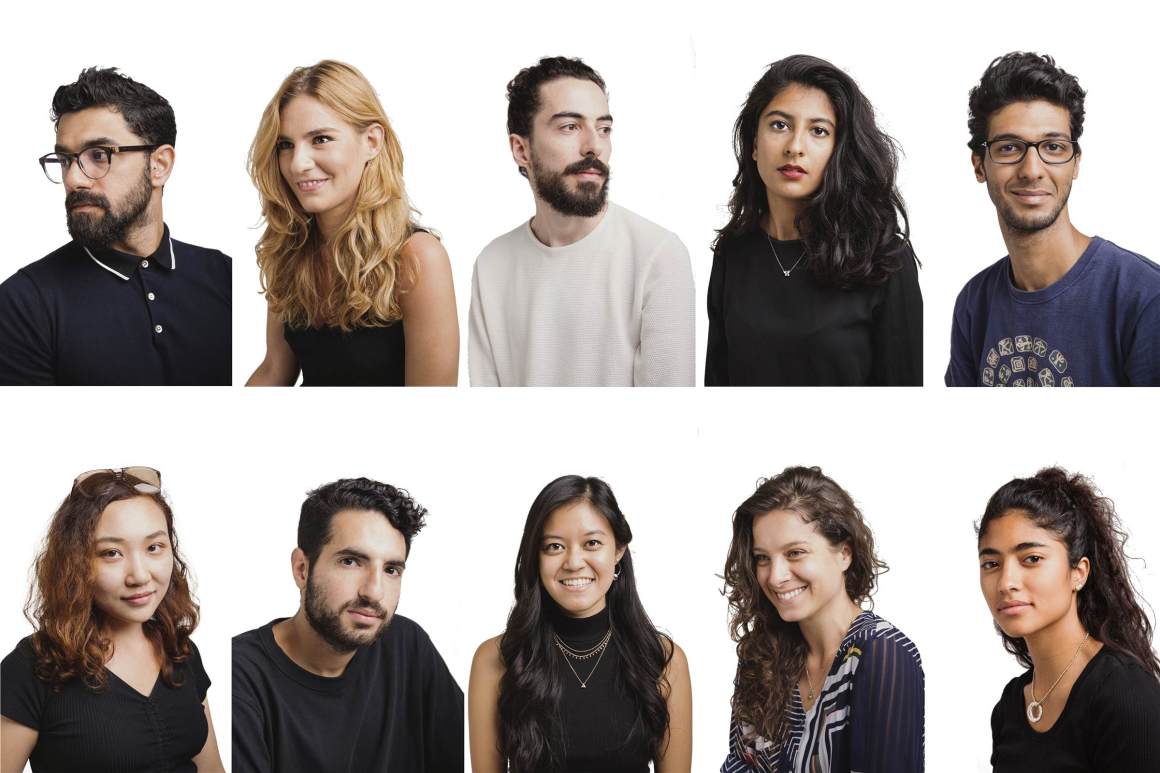
该装置位于圣何塞的Polideportivo公园中一条受污染的城市水道和一条铁路在非正式居民区的交汇处。一侧是铁路,另一侧是有机市场和公共绿色空间。在装置建立之前,这些区域几乎无法联通,只能按照地理和社会收入划分社区。而现在,它已成功将场地高度复杂的地形和其他社会、环境组成空间链接了起来。
Located in San José’s public Polideportivo Park, the installation connects the highly complex topological, social, and environmental components of the site, which sits at the intersection of a contaminated urban waterway, an informal settlement, and a railway on one side, and an organic market and public green space on the other. Previously, the areas were nearly inaccessible to each other, dividing communities along both geographical and socioeconomic lines.
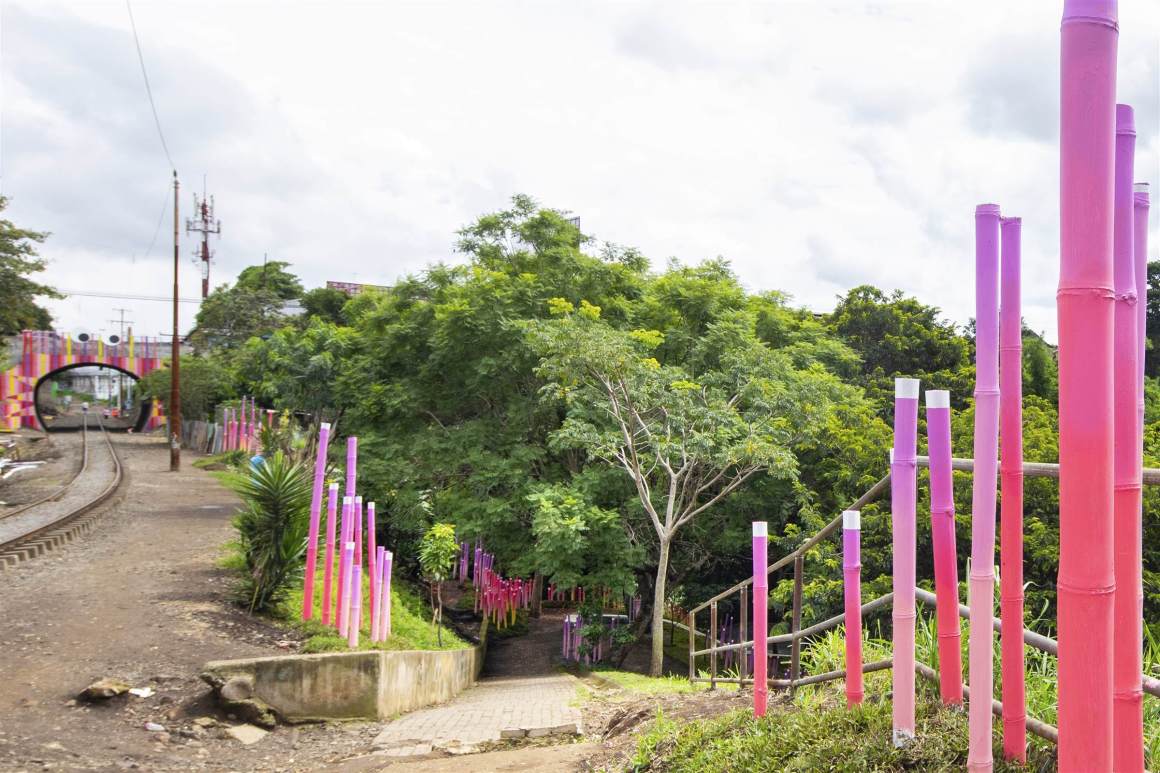

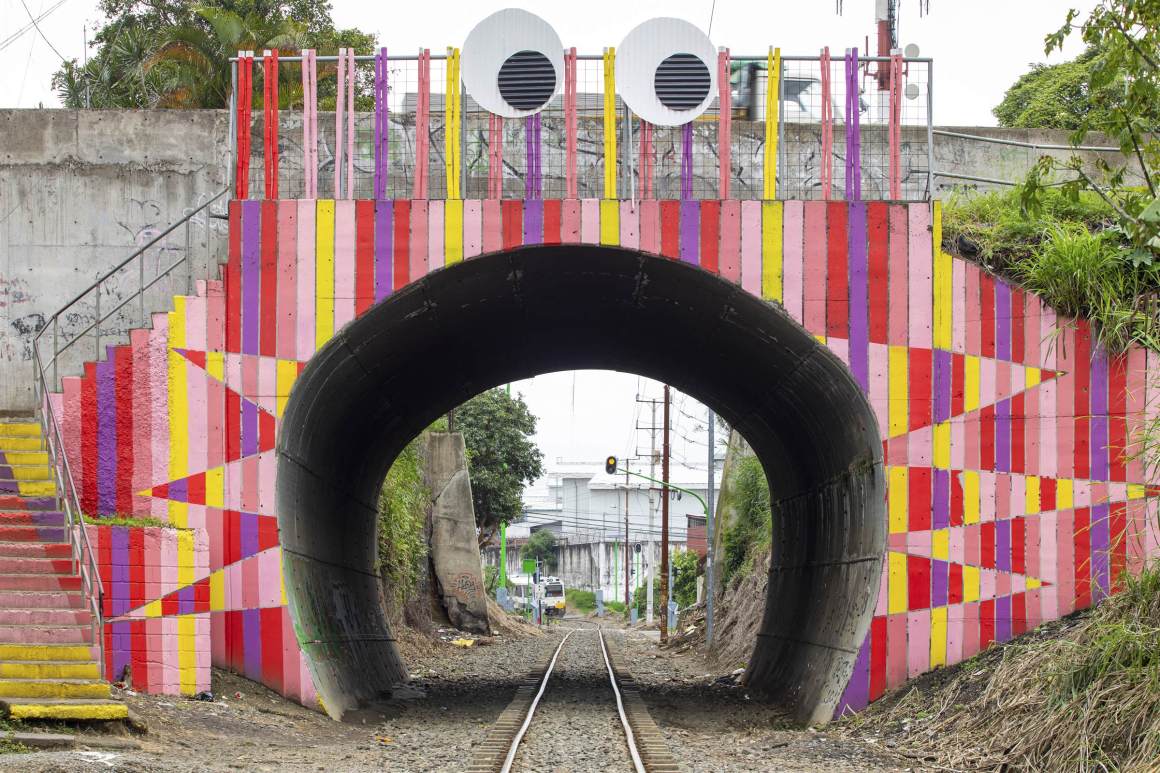
为了在这些不同的场所之间建立空间和视觉上的联系,参与者采取了一系列的物理和社会措施,来统一场地的不同区域。包括清除垃圾、过度生长的植物和令人望而生畏的安全护栏,同时与社区居民及其他利益相关方合作,为其在设计改造中得到社区支持奠定了基础。
Forging a spatial and visual connection between these diverse conditions, the participants undertook a series of physical and social actions to unify the disparate areas of the site.Removing trash, overgrowth, and intimidating security fencing, paired with outreach to neighborhood residents and stakeholders, helped to lay the groundwork for a design intervention with community support.

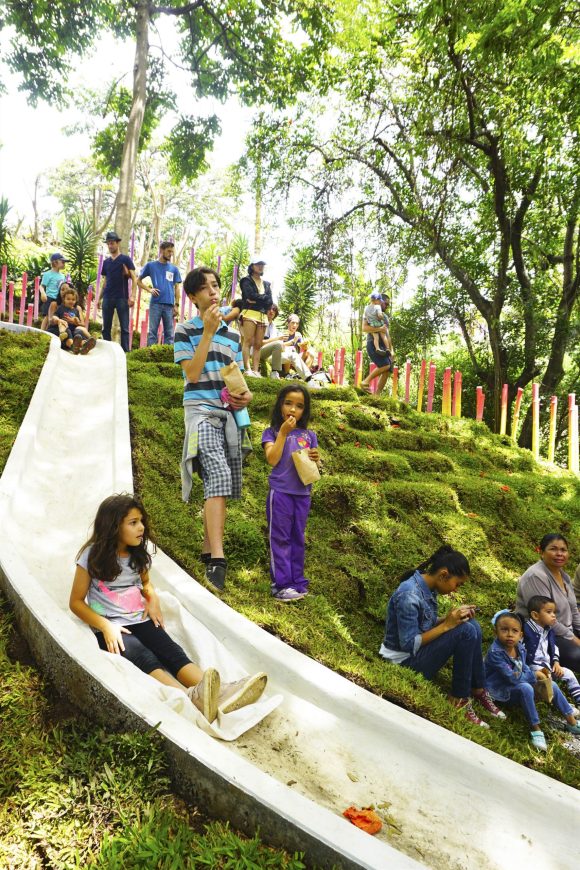

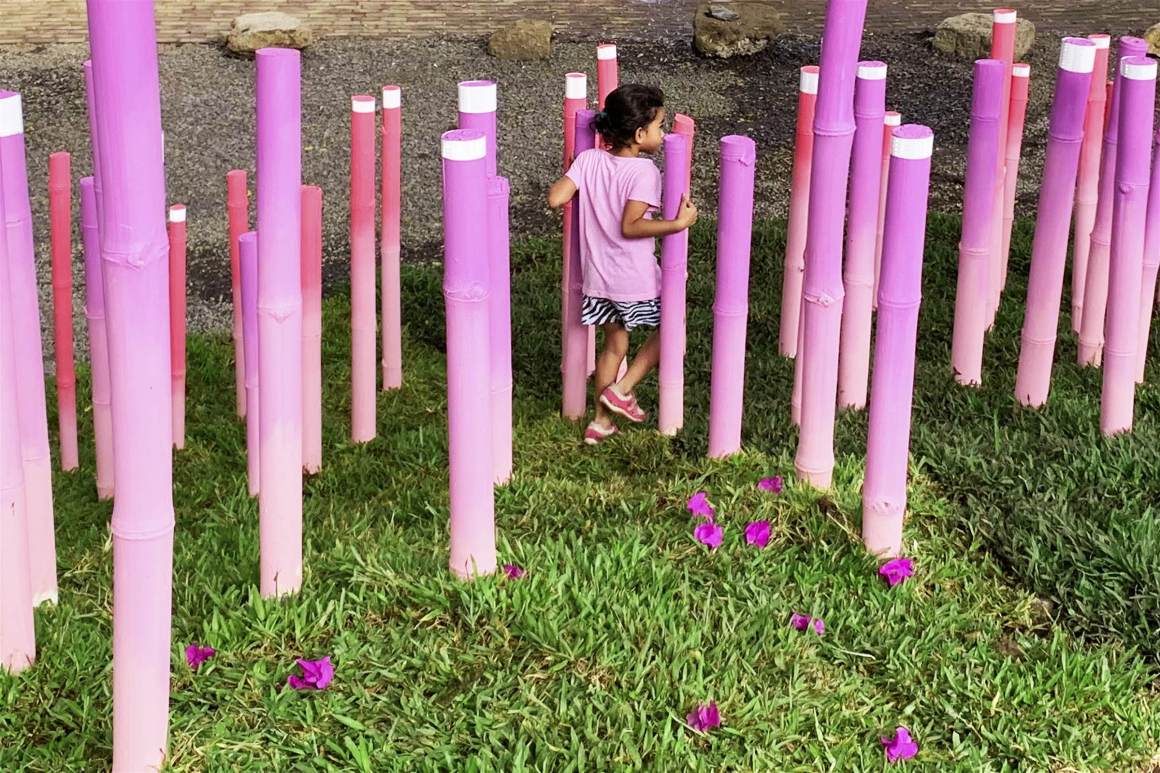
最后呈现出来的便是满山遍野被涂成渐变的黄色,金橙色,桃红色和紫色的竹竿。他们共同组成了一条蜿蜒的小道,连接了圣荷西公园的主要节点以及高处非正式居民区附近的铁路。同时,充当竹子图腾基座的不同形状和大小的草丘也帮助进一步塑造了公园的地形。该装置占地面积约2000平方米,由600个填充着砂砾和碎石的回收利用的轮胎(作为土丘和土壤蓄水和排水的基础)和总计约1200米的竹子组成。
The result is a field of bamboo sticks painted in a vibrant gradient of yellows, golden oranges, hot pinks, and purples. Together, they create a meandering path linking the main nodes of Polideportivo Park and the railway near the upper informal settlement. The terrain is further shaped by grass-covered mounds of different shapes and sizes, which serve as seating pedestals for the groupings of bamboo totems. Covering a total surface area of approximately 2,000 square meters, the installation is comprised of 600 reclaimed tires filled with gravel and crushed stone (used as a base for the mounds and for soil retention and manage flooding) and approximately 1,200 linear meters of bamboo.
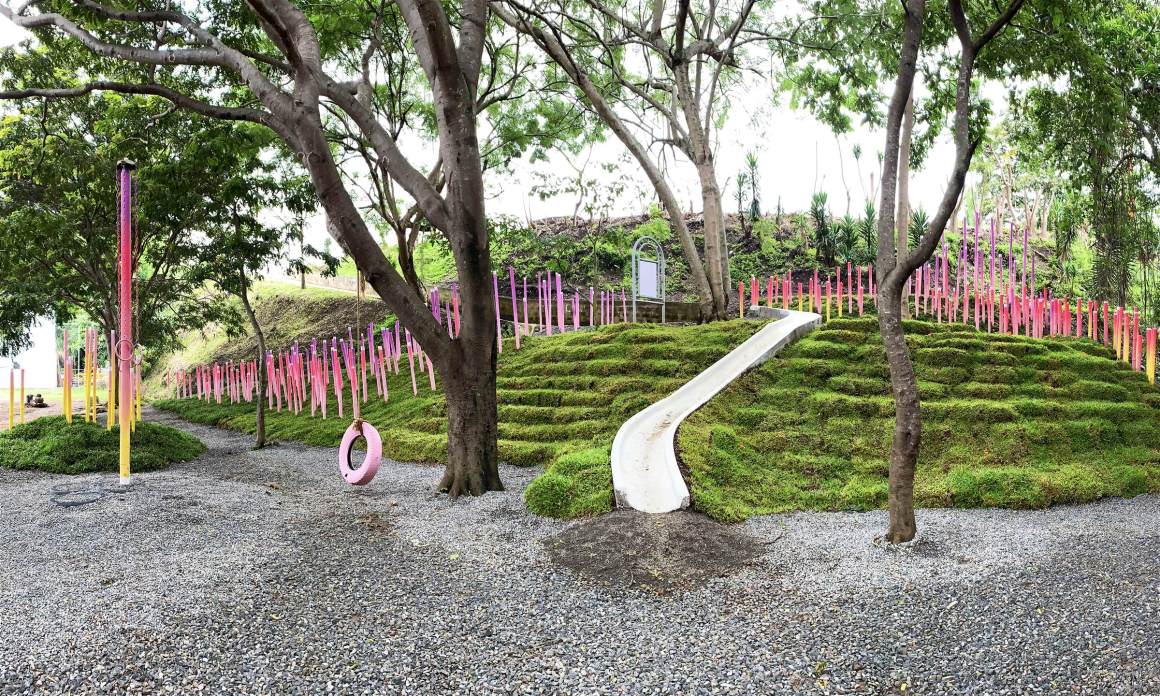
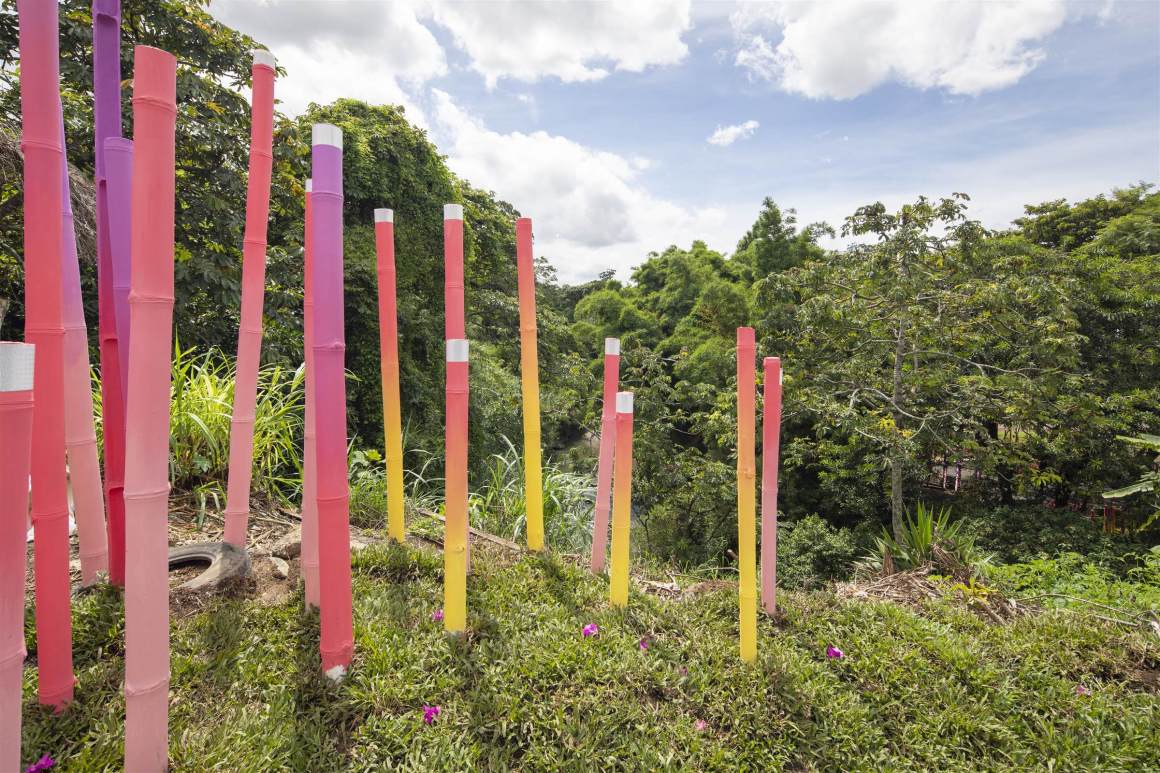
除了色彩丰富和趣味性之外,该装置还融入了环境友好设计。为了提升社区对该地区空气污染的认识,竹竿的颜色可以作为反映污染水平的指示器,从黄色(非常低)到紫色(非常高)分别表示不同的污染程度。各个区域采用的色调是由团队在项目早期阶段测量的准确空气污染数值决定的。
In addition to being colorful and playful, the installation also serves a sophisticated environmental purpose. In order to raise community awareness around air pollution in the area, the color palette of the bamboo poles works as an indicator of pollution levels, varying from yellow (very low) to purple (very high). The hues employed in each area are informed by accurate air pollution measurements taken by the team during the early phases of the project.

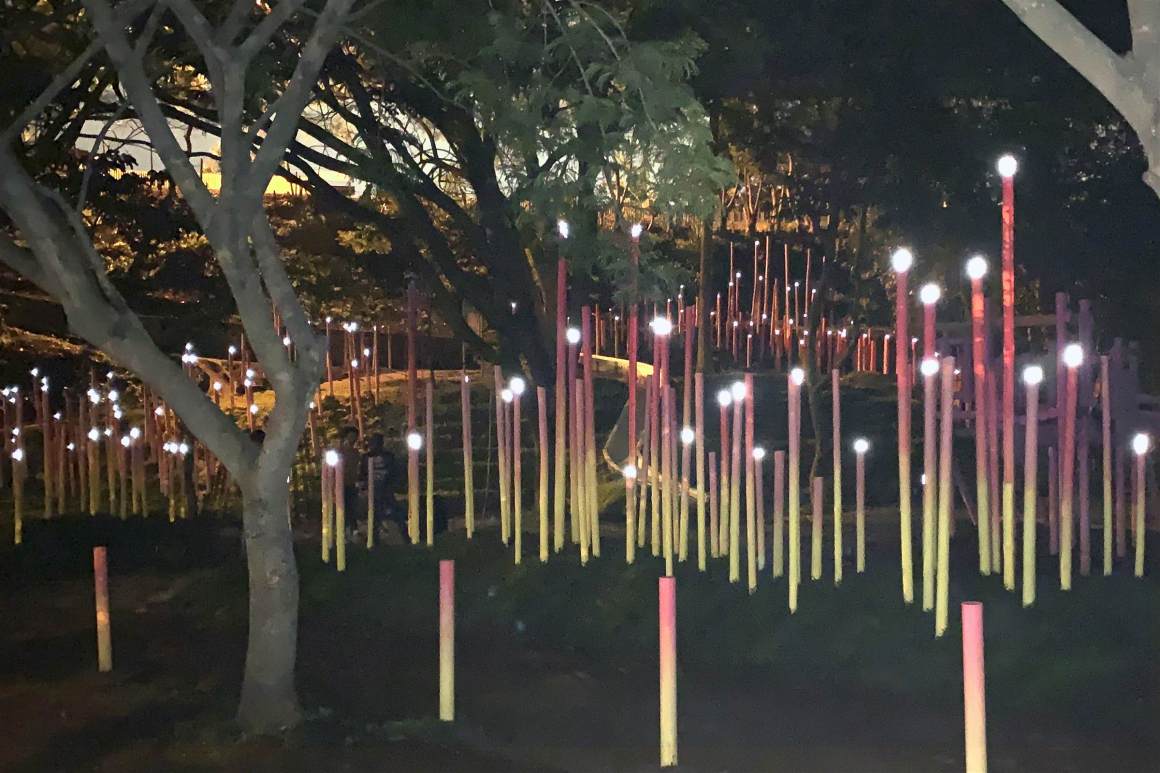
Parque O2的环保设计是积极且富有教育意义的。竹子上的涂料与二氧化钛(TiO2,一种具有高度光催化的活性化学物质)混合后,可以帮助减少空气污染。当竹子上二氧化钛被紫外线激活后,与空气中的颗粒物和污染物作用,可以将其转化成有机分子,最后被竹子表面的雨水冲走。虽然二氧化钛已经在墨西哥和欧洲的某些混凝土表面中成功应用,但这还是首次应用于不规则区域中的分散表面(竹竿)。
Parque O2’s environmental engagement is active as well as educational. By mixing the paint coating the bamboo with Titanium Dioxide (TiO2), a highly photo-catalytic and reactive chemical, the installation actually mitigates the polluted air itself. TiO2 is activated by UV sunlight, and when exposed to particulate matter and pollutants has the power to convert them into organic molecules, which then can be washed off the surface of the bamboo by rain. TiO2 has been used successfully in Mexican and European prototypes, mainly as an ingredient in concrete façades, however this is the first time that it is employed in a scattered surface (field of bamboo sticks) over an irregular area.
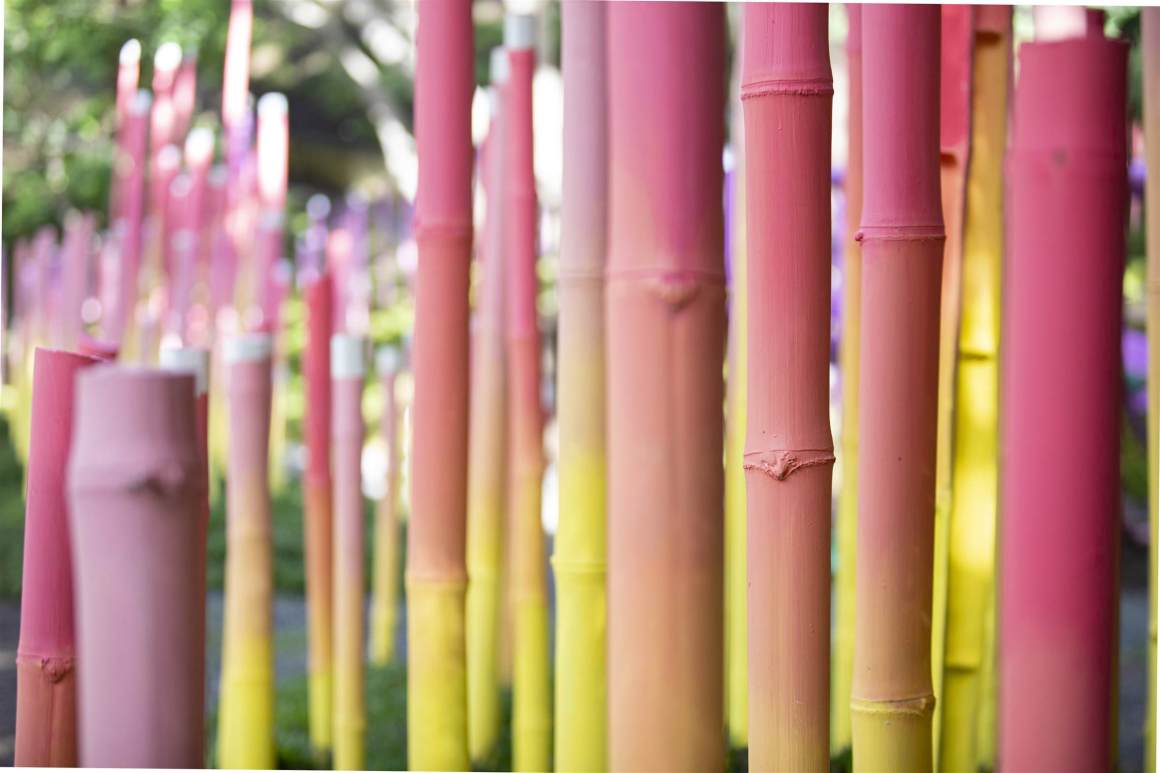
装置的方方面面——包括美学和功能性——都是为了吸引当地社区的参与而设计的,社区中的许多人都与FUNdaMENTAL团队密切合作,参与了整个设计-构建的过程。比如项目前期的调研以当地城市/环境倡议和非营利组织的工作为基础,设计过程中与当地建筑专业的学生交流,由大学教师和专家进行评审得出最优提案,最后用当地私企和政府捐赠的材料和资源进行建造。现场劳动力主要由参与者,志愿者和当地居民组成,包括夜间睡在公园里的几名临时社区成员。建造的每个阶段都以上一个为基础,加深参与者对设计建造过程的了解——由此引入了更多的建议来完成建设。
All aspects of Parque O2 — both aesthetic and functional — were designed with the intent to engage the local community, many of whom were involved throughout the entire design-build process and worked closely with the FUNdaMENTAL team. Initial site research was done with building on the work of local urban/ environmental initiatives and non-profits. The design process was developed in communication with local architecture students and reviewed by University faculty and experts. The resulting proposal was constructed with materials and resources donated from both private companies and the regional municipality. Onsite labor was a combination of participants, volunteers and local residents including several members of the transient community that sleep in the park at night. Each phase built on the next, expanding participants understanding of the design-build process- executing a built work by incorporating more voices into the process.
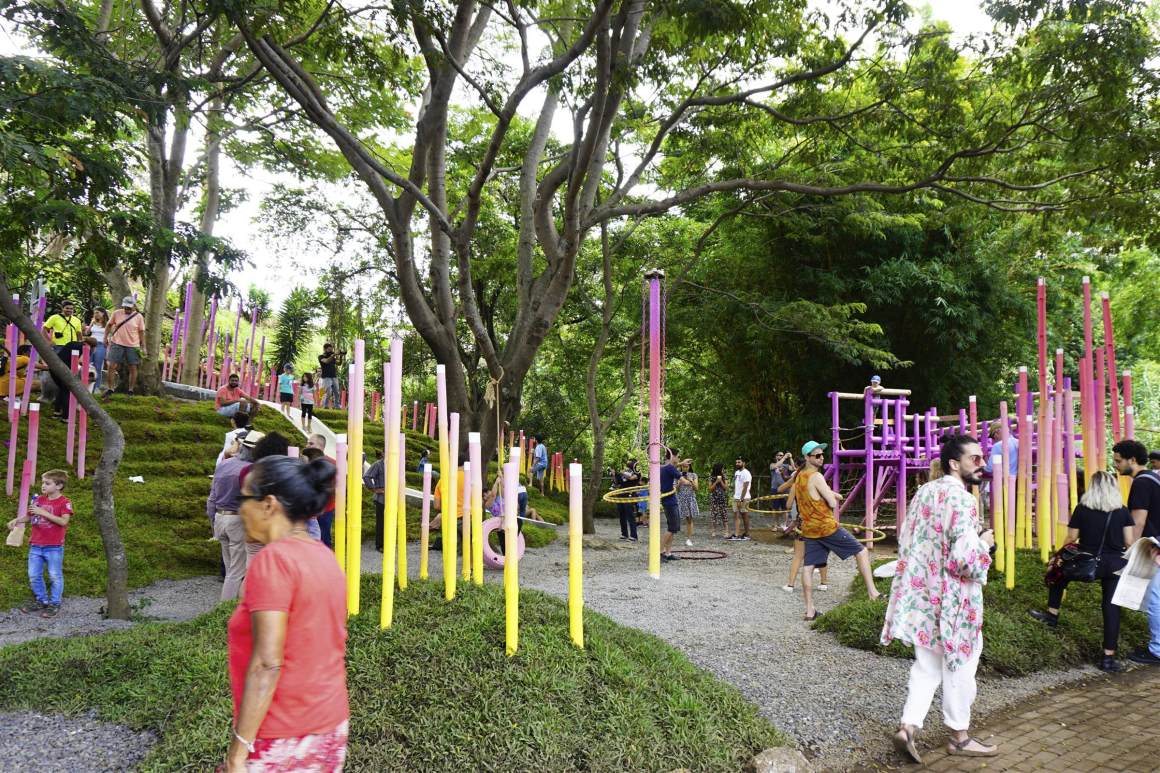
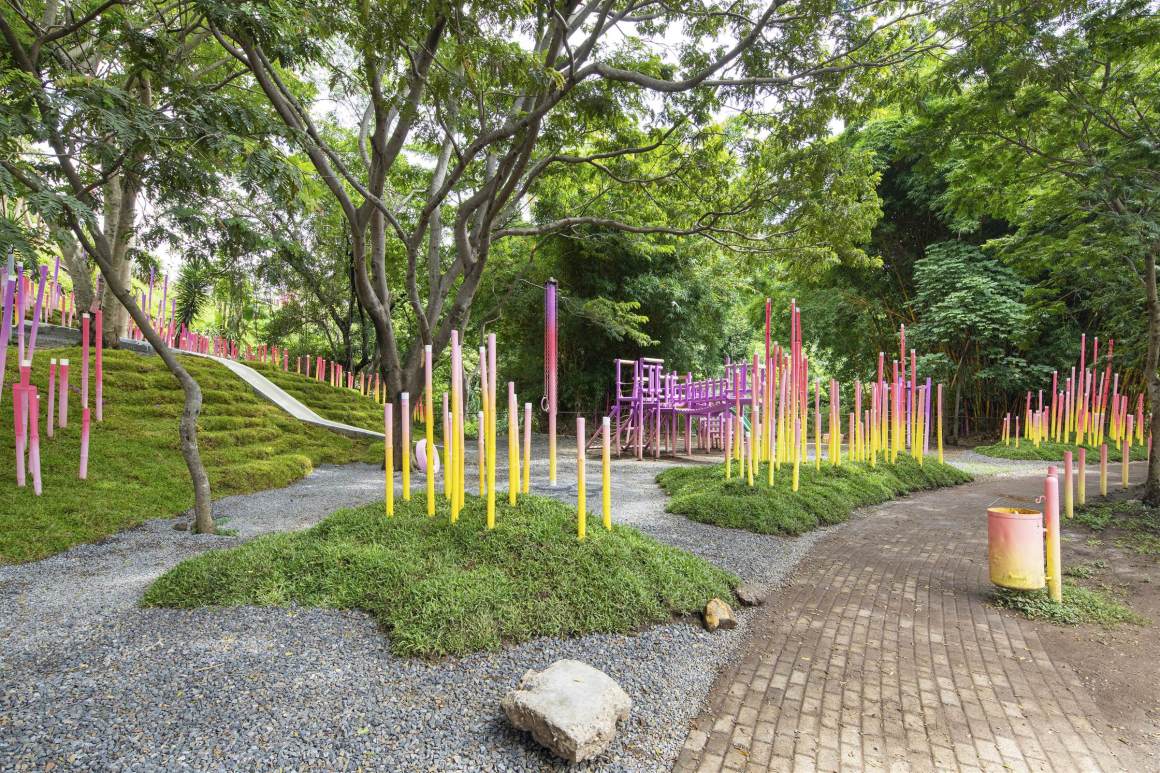
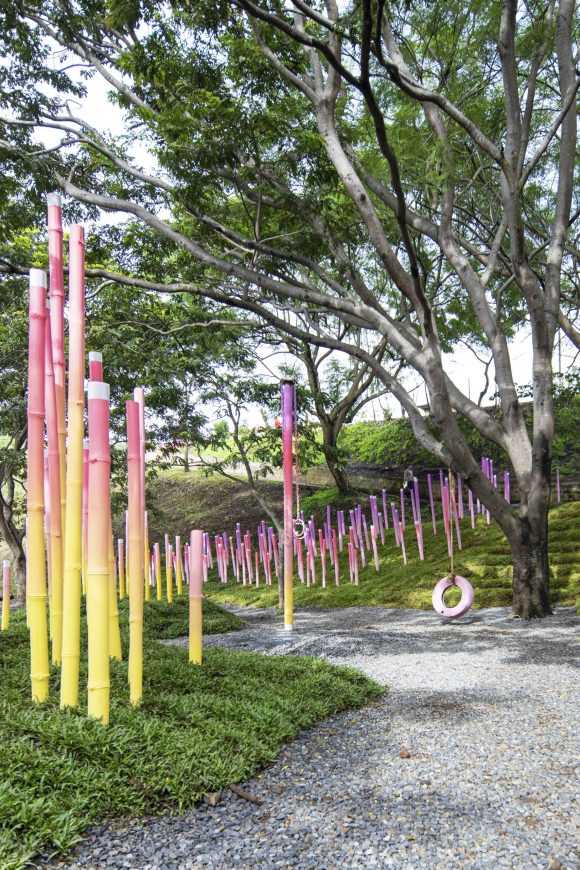
促进对各种设施的参与和尊重,从而保证其可持续性,是所有FUNdaMENTAL项目的一个重要组成部分。用Taller KEN 格雷戈里·梅利托诺夫的话来说,“这一经验有助于公司确立公共领域的工作方法:向非传统受众传播和应用其设计理念。”
This is an essential component of all FUNdaMENTAL Design Build Initiative projects; engendering daily involvement and respect for the various installations, which encourages their future sustainability. In the words of Taller KEN’s Gregory Melitonov, “This experience has helped the practice establish its approach to working in the public realm; communicating and applying its design ethos to non-traditional audiences.”
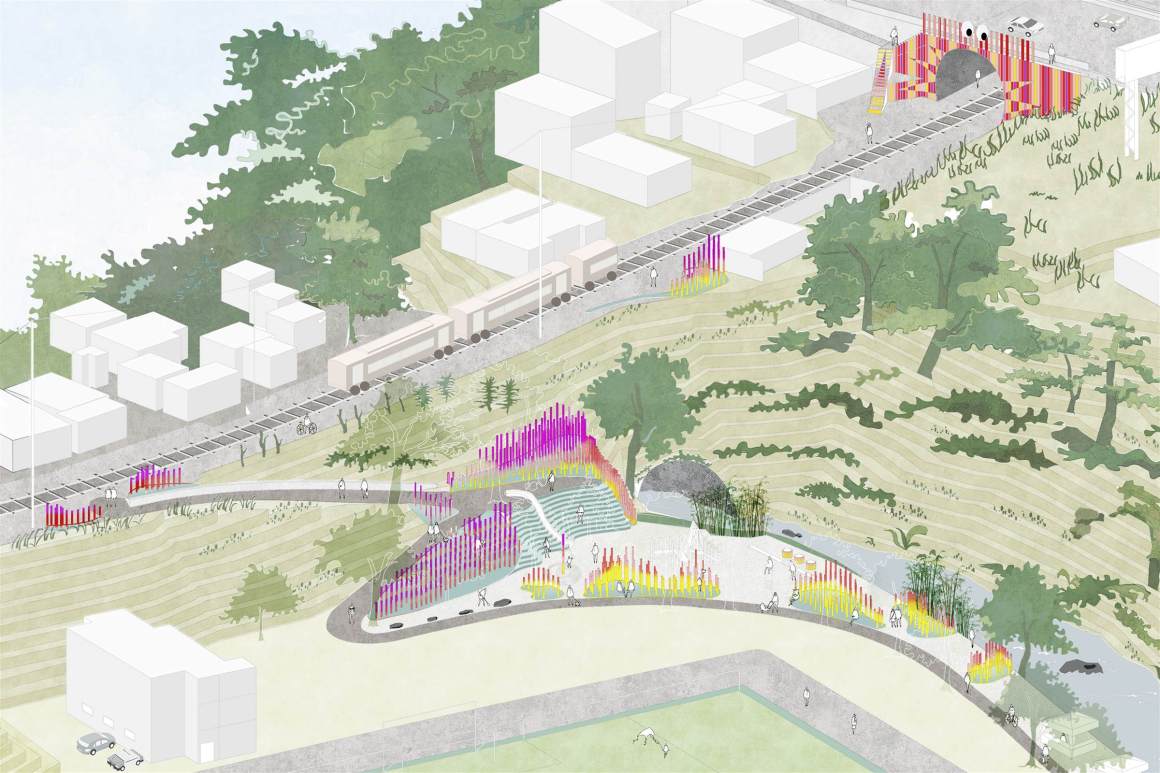
▼剖面图 Section

项目名称:Parque O2
项目地址:哥斯达黎加 圣何塞 圣荷西的公园
主办方:Taller KEN
团队成员:Sheryl Wadehra (印度), Benjamin Hakimian (美国), Carmen Chee (美国), Li AnHong (中国), Laurence Von Lignau (海地), Waddah Dridi (突尼斯), Serkan Ates (土耳其), Riccardo Zocche (意大利), Hrabrina Nikolova(保加利亚), Florence Méthot (加拿大)
当地学生:Andrei Seredin, Diego Blanco, Johana Vargas, Valeria Murillo, Kéndary Rojas
支持协助:Municipalidad de San José and Parque Polideportivo de Aranjuez with A-01, Alejandro Cruz, Barrio, Bruna, Casa Botánica, CCDR San José, Edificio Steinvorth, Glidden, Grupo aie, PPG Paints, Río Urbano, Rutas Naturbanas, Selina, SJO ¡Vive!, Tecnológico de Costa Rica (TEC), The Globe Program, Universidad de Costa Rica
图片来源:Andres Garcia Lachner (场地照片), Leo Carvajal (团队肖像)
Project name: Parque O2
Location: Polideportivo de Aranjuez, San José, Costa Rica
Organizers: Taller KEN
Team members: Sheryl Wadehra (India), Benjamin Hakimian (USA), Carmen Chee (USA), Li AnHong (China), Laurence Von Lignau (Haiti), Waddah Dridi (Tunisia), Serkan Ates (Turkey), Riccardo Zocche (Italy), Hrabrina Nikolova(Bulgaria), Florence Méthot (Canada)
Local student participants: Andrei Seredin, Diego Blanco, Johana Vargas, Valeria Murillo, Kéndary Rojas
Supporters: Municipalidad de San José and Parque Polideportivo de Aranjuez with A-01, Alejandro Cruz, Barrio, Bruna, Casa Botánica, CCDR San José, Edificio Steinvorth, Glidden, Grupo aie, PPG Paints, Río Urbano, Rutas Naturbanas, Selina, SJO ¡Vive!, Tecnológico de Costa Rica (TEC), The Globe Program, Universidad de Costa Rica
Photography: Andres Garcia Lachner (site photos), Leo Carvajal (team portraits)
“彩色的竹子给人奇特的视觉享受,独特的环保设计又让人耳目一新。”
审稿编辑: gentlebeats
更多 Read more about: Taller KEN




0 Comments